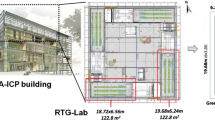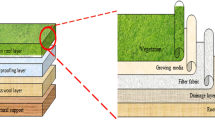Abstract
Purpose
Previous studies have shown the importance of including agricultural capital goods in environmental assessments. In particular for protected crops, greenhouse structural components may account for nearly 30 % of the total in environmental impact categories such as resource depletion and global warming. The lack of appropriate datasets can make it difficult to include these structural components. The present paper provides a modelling approach for the greenhouse inventory stage to provide better assessments of greenhouse production systems.
Methods
In this study, four main greenhouse structures were assessed: a glass greenhouse, a multi-tunnel greenhouse, a local Mediterranean type known as the parral greenhouse and a low-tunnel greenhouse. After selecting the main materials of the structure, we generated equations to calculate the amount of the main structural materials as a function of the main greenhouse dimensions. We performed a quality assessment of the data used for different greenhouse structures. We also calculated a simplified environmental assessment made by the different structures to the climate change category in order to test the effects of the different amounts of material in the four greenhouse types.
Results and discussion
Equations to calculate the amount of the main greenhouse materials as a function of greenhouse size are provided. For the four greenhouse types under consideration, statistical correlations showed a good fit between the amounts of greenhouse materials and the parameters related to the main greenhouse dimensions, such as greenhouse perimeter, surface and volume. The results from the complementary impact assessment study show that glass greenhouses contributed the most in the climate change category, with an average value of 2.9 kg CO2 eq m−2. After variability was taken into account, multi-tunnel and parral greenhouses showed similar values of between 0.5 and 1.3 kg CO2 eq m−2, while low-tunnel greenhouses had the lowest ranges, between 0.4 and 0.6 kg CO2 eq m−2. The environmental assessment was done using the square metre as a reference flow, so the actual impact depends on the functional unit selected, which is usually the yield.
Conclusions
Application of the equations developed in this study provides an easy way to calculate the quantity of materials used to make greenhouses of different dimensions, thus resulting in more accurate calculation of greenhouse production system impacts. This analysis also highlights the importance of the different amounts of materials used to build these structures and, therefore, the need to include ranges of uncertainty in environmental analyses.


Similar content being viewed by others
References
Antón A (2004) Utilización del Análisis del Ciclo de Vida en la Evaluación del Impacto ambiental del cultivo bajo invernadero Mediterráneo. Doctoral thesis, Universitat Politècnica de Catalunya, Barcelona
Antón A, Muñoz P, Castells F, Montero JI, Soliva M (2005) Improving waste management in protected horticulture. Agron Sustain Dev 25:447–453
Bakker J, Bot G, Challa H, Van de Braak N (1995) Greenhouse climate control, an integrated approach. Wageningen Pers, Wageningen.
Boulard T, Raeppel C, Brun R, Lecompte F, Hayer F, Carmassi G, Gaillard G (2011) Environmental impact of greenhouse tomato production in France. Agron Sustain Dev 31:757–777
Castilla N (2004) Invernaderos de plástico. Tecnología y manejo ed. Mundiprensa, Madrid
CEN (2001) EN 13031. Greenhouses: design and construction—part 1: commercial production greenhouses. European Committee for Standardization
EFSA-PPR (2009) EFSA-PPR project on “Data-collection of existing data on protected crop systems (greenhouses and crops grown under cover) in Southern European EU Member States”. Agricultural University of Athens
EC (2013) Product Environmental Footprint Guide (draft) Brussels. http://ec.europa.eu/environment/eussd/smgp/pdf/annex2_recommendation.pdf
Ekvall T, Tillman A (1997) Open-loop recycling, criteria for allocation procedures. Int J Life Cycle Assess 2(3):155–62
EU-JRC-IES (2010) International Reference Life Cycle Data System (ILCD) Handbook. General guide for life cycle assessment—detailed guidance. European Commission–Joint Research Centre–Institute for Environment and Sustainability. http://lct.jrc.ec.europa.eu/
EU-JRC-IES (2012) International Reference Life Cycle Data System (ILCD) Data Network—compliance rules and entry-level requirements. European Commission–Joint Research Centre–Institute for Environment and Sustainability: version 1.1, 2012. EUR 24380 EN. Publications Office of the European Union, Luxembourg; http://lct.jrc.ec.europa.eu/
Eurostat (2008) European Commission, Eurostat, Agriculture, Data, Database, Statistics. http://epp.eurostat.ec.europa.eu/portal/page/portal/agriculture/data/database. Accessed on 12 December 2012
Frischknecht R, Althaus H-J, Bauer C, Doka G, Heck T, Jungbluth N, Kellenberger D, Nemecek T (2007) The environmental relevance of capital goods in life cycle assessments of products and services. Int J Life Cycle Assess 11:1–11
IPCC (2006) Intergovernmental Panel on Climate Change. In: Eggleston HS, Buendia L, Miwa K, Ngara T, Tanabe K (eds) IPCC Guidelines for National Greenhouse Gas Inventories, Prepared by the National Greenhouse Gas Inventories Programme. IGES, Japan
ISO-14040 (2006) Environmental management—Life cycle assessment—Principles and framework. International Organisation for Standardisation ISO
ISO-14044 (2006). Environmental management—Life cycle assessment—Requirements and guidelines. International Organisation for Standardisation ISO, Geneva
Kacira M (2011) Total areas in major greenhouse production countries. Greenhouse production in US: status, challenges, and opportunities. Presented at CIGR 2011 Conference on Sustainable Bioproduction WEF 2011, September 19–23, 2011, Tokyo, Japan
Lupsea M, Schiopu N, Tiruta-Barna L (2012) Leaching of construction products during their use stage: proposal for a reliable LCI of the released substances in water and soil. International symposium on Life Cycle Assessment and Construction. Nantes, France—http://lca-construction2012.ifsttar.fr/downloads/s1/12120_Lupsea.pdf
Martínez-Blanco J, Muñoz P, Antón A, Rieradevall J (2011) Assessment of tomato Mediterranean production in open-field and standard multi-tunnel greenhouse, with compost or mineral fertilizers, from an agricultural and environmental standpoint. J Clean Prod 19(9–10):985–997
Matallana A, Montero JI (1995) Invernaderos, diseño, construcción y ambientación, 2nd edn. Mundiprensa, Madrid
Montero JI, Antón A, Torrellas M, Ruijs M, Vermeulen P (2011) Report on environmental and economic profile of present greenhouse production systems in Europe. European Commission. FP7-KBBE-2007-1 Project EUPHOROS (Reducing the need for external inputs in high value protected horicultural and ornamental crops). http://www.euphoros.wur.nl/UK
Nemecek T, Erzinger S (2005) Modelling representative life cycle inventories for Swiss arable crops. Int J Life Cycle Assess 10(1):1–9
Nemecek T, Heil A, Huguenin O, Meier S, Erzinger S, Blaser S, Dux D, Zimmermann A (2003) Life cycle inventories of agricultural production systems. Data v1.01 (2003). Agroscope FAL Reckenholz and FAT Taenikon, Swiss Centre for Life Cycle Inventories. Ecoinvent report no. 15
Pérez-Parra J (1998) Invernadero Parral Almería y su evolución. In: Pérez-Parra J, Cuadrado Gómez I (eds) Tecnología de Invernaderos II. Dirección General de Investigación y Formación Agroalimentaria, FIAPA y Caja Rural de Almería. El Ejido, Almería, pp. 179–192
Robert-Sainte P (2009) Contribution des matériaux de couverture à la contamination métallique des eaux de ruissellement. PhD thesis, Université Paris-Est, 2009, 426 pp
Romero-Gámez M, Antón A, Soriano T, Suárez-Rey EM, Castilla N (2009) Environmental impact of greenbean cultivation: comparison of screen greenhouses vs. open field. J Food Agric Environ 7(3–4):754–760
Russo G, Scarascia-Mugnozza G (2005) LCA methodology applied to various typology of greenhouses. In: van Straten G, Bot GPA, van Meurs WTM, Marcelis LMF (eds) International Conference on Sustainable Greenhouse Systems—GREENSYS 2004, Leuven, Belgium. ISHS. Acta Horticulturae 691, pp. 837–844
Torrellas M, Antón A, López JC, Baeza E, Pérez Parra J, Muñoz P, Montero JI (2012a) LCA of a tomato crop in a multi-tunnel greenhouse in Almeria. Int J Life Cycle Assess 17:863–875
Torrellas M, Antón A, Ruijs M, García N, Stanghellini C, Montero JI (2012b) Environmental and economic assessment of protected crops in four European scenarios. J Clean Prod 28:45–55
Torrellas M, Antón A, Montero JI (2013) An environmental impact calculator for greenhouse production systems. J Environ Manage 118:186–195
Weidema BP, Bauer C, Hischier R, Mutel C, Nemecek T, Reinhard J, Vadenbo CO, Wernet G (2012) Overview and methodology. Data quality guideline for the Ecoinvent database version 3. Ecoinvent Report 1(v3). St. Gallen: The Ecoinvent Centre
Acknowledgements
This work received financial supported from the projects ‘Life Cycle Impact Assessment Methods for Improved Sustainability Characterisation of Technologies’ (LC-IMPACT), Contract No. 243827 and ‘Efficient Use of Inputs in Protected Horticulture’ (EUPHOROS) Contract No. 211457, both funded by the European Commission under the Seventh Framework Programme.
Author information
Authors and Affiliations
Corresponding author
Additional information
Responsible editor: Ivan Muñoz
Rights and permissions
About this article
Cite this article
Antón, A., Torrellas, M., Raya, V. et al. Modelling the amount of materials to improve inventory datasets of greenhouse infrastructures. Int J Life Cycle Assess 19, 29–41 (2014). https://doi.org/10.1007/s11367-013-0607-z
Received:
Accepted:
Published:
Issue Date:
DOI: https://doi.org/10.1007/s11367-013-0607-z




